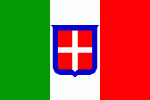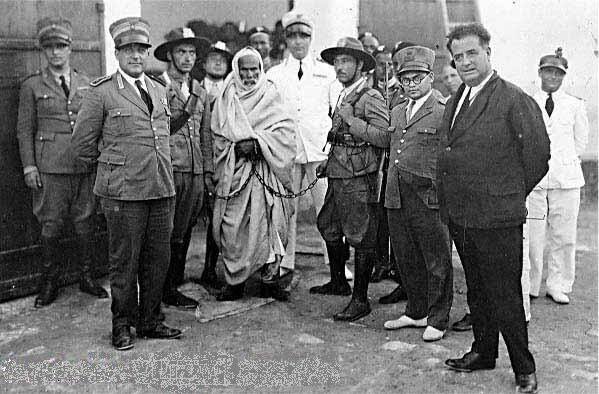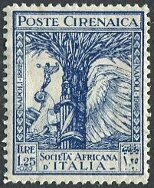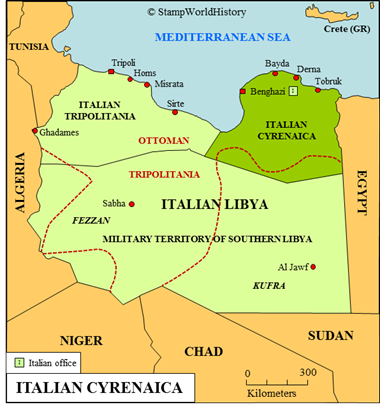
Italian Cyrenaica
Quick reference
General issues: Italian colony 1923-1934
Country name on general issues: Cirenaica
Currency: 1 Lira = 100 Centesimi 1923-1934
Population: 132 000 in 1931
Political history Italian Cyrenaica
The opening stages
Italian Cyrenaica is located in northern Africa in the current Libya. In the 19th century the future Italian Cyrenaica is part of the Ottoman vilayet or province of Tripolitania that also includes the Tripolitania and Fezzan regions. Italy in the 19th century has commercial interests in Ottoman Tripolitania and by the late 19th century Italy looks to take possession of Ottoman Tripolitania. In 1911, Italy declares war on Turkey. Italy is victorious and in 1912 the Turks, by way of the treaty of Lausanne, agree to withdraw from Tripolitania – de jure Ottoman Tripolitania is ceded to Italy in 1923.
The Italians, after 1912, divide their Libyan possessions in three parts. In the coastal region the colonies of Italian Cyrenaica and Italian Tripolitania are established, each with a governor. The southern possessions – the Fezzan and Kufra regions – are administered by the military as the Military Territory of Southern Libya. These possessions together are referred to both as ‘Italian North Africa’ and ‘Italian Libya’.
Establishing Italian rule
Having gained control only over the coastal regions in 1912, Italy next sets out to bring all of Ottoman Tripolitania under its control – an effort in which it will only partly succeed. In 1915, Italy joins the Allies in WWI and the troops from Libya are withdrawn, to be deployed in the European theaters of war. Local leaders reassert their authority over most of Libya. Italian control is de facto, between 1915 and 1919, limited to a number coastal towns. After WWI, the Italians set out to reestablish their authority in Libya. Initially, they do so by making concessions to the local leaders. In Italian Cyrenaica an agreement is signed with the leaders of the Senussi order, a religious order that had assumed substantial worldly power in large parts of Libya – the Senussi leader Idris will eventually ascend to the throne of the kingdom of Libya in 1951.

Omar Mukhtar at his arrest in 1931. Omar Mukhtar was the leader of the Senussi forces fighting Italy in Italian Cyrenaica. When the Italians had established themselves in most of Italian Cyrenaica, he continued to fight a guerrilla war from the Kufra region until his capture in 1931.
Things take a very different turn when Mussolini, in 1922, comes to power in Italy. Mussolini launches the ‘Riconquista’[1]‘Reconquest’ . The Italians abrogate all prior agreements and, through military force, assert their authority in Libya. Libya is successively brought under effective Italian rule. The Senussi leadership goes into exile in Egypt in 1923 – continuing a guerrilla war from the southern region of Kufra. Italian Cyrenaica is finally brought under effective Italian rule between 1926 and 1928. The existence of Italian Cyrenaica as a separate colony comes to an end when, in 1934, the colonies of Cyrenaica and Tripolitania are joined to form what is now officially called the colony of Italian Libya.
The population of Cyrenaica is of Berber, Arab and Turkish origin and is almost fully Arabized. The culture is akin to that of the Mashriq – the eastern Arab world stretching from Cyrenaica to the Middle East. As such, the population of Cyrenaica is distinct from the population in Tripolitania that is more oriented to the Mahreb – the western part of the Arab world that stretches from Morocco across Algeria and Tunisia to Tripolitania – and the population in the sparsely populated southern part of Libya.
Aftermath
During WWII, Libya develops into a major theater of war. Fortunes change between 1940 and 1943, but events eventually lead to Allied victory and the eviction of Italy from Libya in 1943. British and French forces occupy the country establishing first military administration and then civil administration. Italy formally cedes Italian Libya in 1947. In 1951, Libya will gain independence as the kingdom of Libya.
Postal history Italian Cyrenaica

1928 – A complex allegory symbolizing fascism and victory. Issued for the anniversary of the Italian Africa Society.
In Ottoman Tripolitania the stamps of the Ottoman Empire were used. Italy opened an office abroad in Benghazi in 1901. Stamps are issued for use in the Benghazi office from 1901.
Italy issues stamps for its possessions in Libya from 1912. These issues will be used in all of Italian Libya from 1912 until 1943. From 1923, concurrently with the general issues for Italian Libya, stamps are issued for both Italian Cyrenaica and Italian Tripolitania. These are almost exclusively commemoratives – both overprints on Italian stamps and issues of designs common the Italian colonies. The stamps of Italian Cyrenaica are, from 1934, superseded by the issues for Italian Libya. These to be superseded, from 1943, by the issues of the British military administration – from 1943 to 1948 the issues for the Middle East Forces and from 1948 to 1950 the issues for Tripolitania that are also used in Cyrenaica. The issues of the British administration are, from 1950, superseded by the issues of the emirate of Cyrenaica and from 1951 by the issues of independent Libya.
Album pages
← Previous page: Italian coloniesNext page: Italian East Africa →


